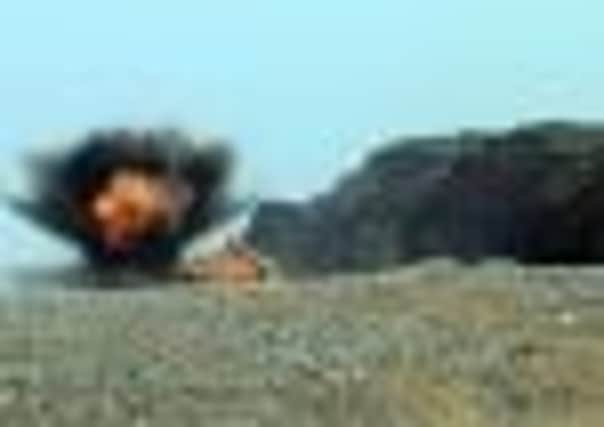The beach where it’s not safe to pick up the shells


But after being buried beneath the field where they fell relatively harmlessly nearly a lifetime ago, hundreds of old practice bombs sparked a security alert when they tumbled into view during a landslide on the East Coast.
And although they were never intended to cause harm, they were at the centre of a one-mile exclusion zone yesterday when some of those which appeared and apparently posed a threat were blown up by the RAF in a operation that is still going on.
Advertisement
Hide AdAdvertisement
Hide AdOne bright orange fireball encircled by a thick black cloud flashed before the eyes and was gone, seconds before the deep thumping sound of the explosion carried to those watching further along the sands.
The 15lb shells, some dating from the Second World War, suddenly made beachcombing a potentially lethal pursuit and had prompted a call to police when a dog walker found them lying on the sand at Mappleton, near Hornsea, on Saturday afternoon.
They had been dropped on a bombing range at the now disused RAF Cowden.
Having so dramatically revealed them, the sea seemed reluctant to give them up, with high tides permitting only a cursory inspection from the officers who were first called to the scene.
Advertisement
Hide AdAdvertisement
Hide AdThe scale of the find was not fully appreciated until Army bomb disposal experts arrived the following day.
The clear-up operation began immediately and with some haste.
Staff from the Defence School of Transport at Leconfield, near Beverley, arrived in a truck and spirited some of the shells away to an unknown fate.
Meanwhile, about 15 controlled explosions were carried out on the beach by an Explosive Ordnance Disposal unit, who had made the long journey from Catterick in North Yorkshire.
Advertisement
Hide AdAdvertisement
Hide AdBut the “several hundred” bombs identified by police were judged to number up to 1,000 and it was clear the drama unfolding on this normally quiet stretch of the coast would last a little longer.
The responsibility was then handed to a four-man team from RAF Wittering, near Peterborough in Cambridgeshire, who expect to be on site until the weekend.
Their introduction was not inter-service rivalry but a matter of expertise and protocol, with the RAF being responsible for the disposal of most “air-delivered” weapons.
The exception to this rule are German bombs from the Second World War, which are a speciality for the Royal Engineers.
Advertisement
Hide AdAdvertisement
Hide AdThey bring generations of hard-earned knowledge acquired by their forefathers when dealing with unexploded bombs during the Blitz.
But while today’s bomb disposal experts are happy to talk about their work, they frown if a civilian refers to the Mappleton bombs as “devices”, as this suggests improvised explosive devices (IEDs), the murderous weapons of choice of insurgents that have wreaked such havoc in Iraq and Afghanistan.
For Sergeant Robbie Stewart, a member of the RAF team, it was all part of the job.
“We identify them, see if we can say whether they’ve been fired and if we can’t we have to assume they haven’t been fired,” he said.
Advertisement
Hide AdAdvertisement
Hide Ad“We line them up in a stable and safe area and place explosives in a quite specific way so we can crack them or detonate whatever explosives may be there. We then have to inspect them again.”
Inspector Mark Coulthard, from Humberside Police, warned against souvenir hunting.
“Although not live munitions, they do pose a danger as they have flash charges in them,” he said. “I would advise any member of the public finding such an item to ensure that they leave it alone and phone the police to notify us so that we can arrange the necessary measures to make them safe. On no account, should any person pick these items up and take them home.”
He added: “The likelihood of more finds is high.”